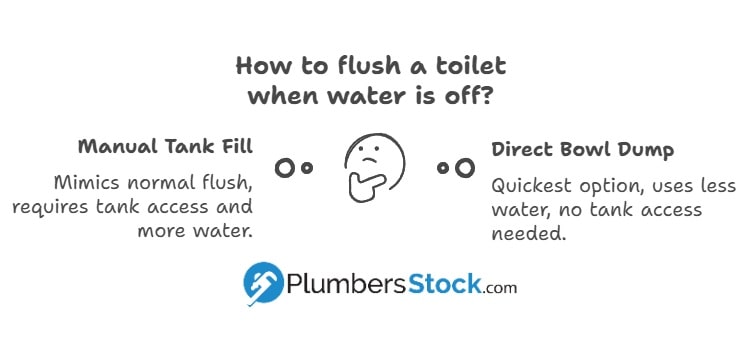
Whether you’re dealing with a plumbing emergency, water main break, or planned maintenance, losing access to running water can be inconvenient, especially when it comes to flushing your toilet. Fortunately, you don’t need a working water supply line to flush most standard toilets.
In this guide, we’ll show you how to flush a toilet when the water is off, using simple methods that require minimal tools. These techniques are safe for your plumbing and can help maintain sanitary conditions until the water is restored.
Why You Can Still Flush Without Running Water
Toilets function by emptying a tank of water into the bowl, which creates enough force to push waste through the drain system. If you manually add water to the tank or bowl, you can replicate this process, even without running water.
As long as your toilet’s drainage system is clear and functional, you can manually flush it by adding water directly into the bowl or tank. It’s not ideal in the long term, but it works in emergencies.
Method 1: Manual Tank Fill (Most Similar to Normal Flush)
This method mimics how your toilet operates typically by filling the tank manually.
What You’ll Need:
- Clean bucket (2–3 gallons)
- Source of clean water (bathtub reservoir, bottled water, rainwater)
- Optional: funnel for easier pouring
Steps:
- Remove the tank lid and set it aside carefully.
- Pour about 1.6 gallons of clean water into the tank—this is roughly what most modern toilets use per flush.
- Press the flush lever. The toilet should flush normally.
From an American Standard product manual: “Manual filling of the tank should not exceed normal fill levels marked inside the tank; overfilling may cause overflow.”

Method 2: Direct Bowl Dump (Quickest Option)
If you don’t want to open up your toilet tank or you’re short on time:
What You’ll Need:
- A bucket with at least one gallon of clean or graywater
Steps:
- Fill your bucket with about one to two gallons of water.
- Pour quickly and steadily into the center of the bowl from waist height.
- The sudden rush will force waste down through gravity and siphoning action.
Best Water Sources When Supply Is Off
- A bathtub filled ahead of time
- Bottled drinking water (if necessary)
- Melted snow (boiled if possible)
- Pond or pool water (suitable only for flushing—not handwashing!)
- Caught rainwater in buckets/barrels
Avoid dirty mop buckets or contaminated sources unless absolutely necessary—they could introduce bacteria into your bathroom environment.
Important Considerations
-

Check out one of our most popular toilets, built for a 10″ rough-in configuration. Avoid clogs: Manual flushing won’t help if there’s already a blockage in your drain line.
- No boiling liquids: Avoid pouring hot liquids directly into porcelain bowls, as they may crack due to thermal shock.
- Avoid splashing: Pour steadily but avoid aggressive dumping that could splash contaminated contents outward onto floors or walls.
If you’re concerned about hygiene during extended power outages, consider upgrading to a toilet with built-in bidet functionality later.
FAQ: Flushing Toilets Without Running Water
Q: Can I use graywater from dishwashing or laundry?
A: Yes—but only for direct bowl pour methods. Avoid putting soapy or greasy graywater into tanks where it could damage components, such as fill valves.
Q: How many times can I manually flush before needing to refill the stored water?
A: Each full-flush requires about one to two gallons, depending on your model. A standard bathtub holds around forty to fifty gallons—enough for several dozen manual flushes if rationed properly.
Q: Will this damage my toilet?
A: No, as long as you’re careful not to overfill tanks or pour scalding liquids into cold porcelain bowls. Stick with room-temperature sources whenever possible.
Q: Should I remove anything from inside my toilet before pouring?
A: Not usually, but check that no cleaning tablets are in use that could react poorly with alternative waters, such as pool chlorine mixes. If needed, replace damaged components such as flappers, seats, or supply lines here at PlumbersStock.com.
Resources
- Video: Manual Flush
- 1-Piece vs. 2-Piece Toilets
- How to Clean Toilet Bowls and Tanks
- Measure a Toilet Rough In
About the Author
Cliff is a proud Dad and already a Grandpa, if you can believe it! He likes to lift weights, play basketball, hunt, and do just about anything outside. He has been in the construction and plumbing business off and on since 1989 and has tons of experience in many areas of home improvement.
